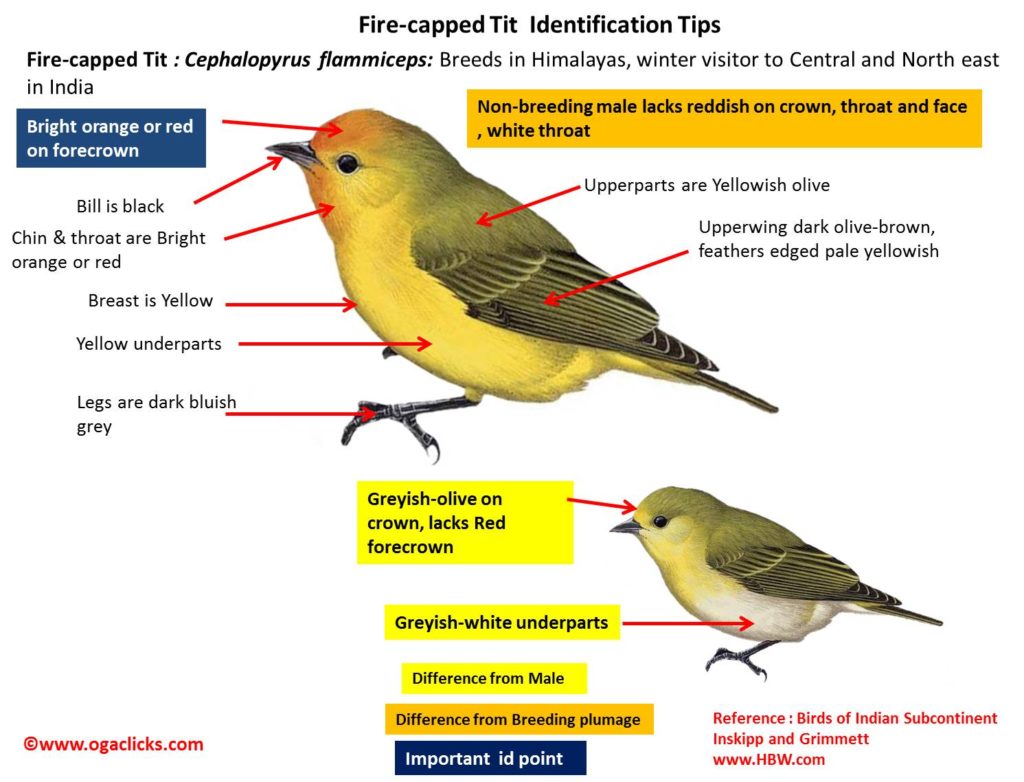Fire-capped Tit

Fire-capped Tit Cephalopyrus flammiceps
Etymology :
- Cephalopyrus : Greek word kephale– head; purrhos – flamecoloured, red
- Flammiceps : Latin word flamma – flame; ceps– capped,crowned
Distribution in India: Resident of Himalayas in India
Description: Size of 8·5–9·5 cm; wt. of 7 g. It is a tiny olive-and-yellow passerine with slightly notched short tail and small, slightly decurved, narrowly conical and sharply pointed bill. The Male of nominate race in breeding plumage has varying amounts of bright orange or red on forecrown, chin and throat; remainder of head and upperparts are yellowish-olive, it is brightest on rump. The upperwing is dark olive-brown, the feathers are edged pale yellowish; tail is blackish-brown and feathers fringed yellowish-green and tipped white .The lores and area around eye are deep yellow, sometimes washed orange or reddish. The underparts are yellow, often quite bright, shading into bright orange or red of throat. The iris is brown to dark-brown; bill is blackish, with some grey. The legs are dark blue-grey. The non-breeding male lacks reddish on crown, throat and face, resembles female but is brighter yellowish-olive above and yellower below, and has whiter throat. Thefemale is duller than male, more greyish-olive on crown and nape, becoming more yellowish-olive on rump and uppertail-coverts, with greyish-white underparts washed pale yellow on belly and flanks. The female in breeding plumage becomes yellower on throat, face and breast, contrasting with off-white lower belly and ventral area.
Habitat: It breeds in broadleaf mountain forest from 1800m to 4000m. On migration it is found in gardens, parks, and willow thickets by rivers and lakesides. In winter it comes down to foothill forest.
Food habits: It eats small invertebrates and some vegetable material liked flower buds, young leaves, and sap. Itforages in middle and upper canopy of tall trees; on passage also in riverine bushes. It forages in tit-like fashion in canopy, swinging upside-down to investigate leaf bunches, or climbs along underside of branches, peering into nooks and crannies. It feeds with tit-like agility, “walks” with deliberate gait like a tiny parrot, sidling along twigs to pull in rolled leaves with bill, and then, while holding leaf securely underfoot, prises it open. It holds larger prey items in foot, extracting soft contents. It is usually found in small parties. It also joins mixed-species flocks, outside breeding season.
Breeding habits: They breed in Apr to Jun. They are monogamous and solitary nester. The male performs short song flight, but more often prefers to deliver song from very top of tall tree. The nest is built entirely by female, with male in close attendance and often singing. The nest is a cup of small rootlets and dry grass, lined with finer grasses and feathers, above the from in hole in tree, preferentially old hole of Woodpecker or Barbet .if necessary they will enlarge existing cavity in soft wood. They lay a clutch of 3–5 eggs. The incubation is done by female only, she sits tight and puffs herself up and hisses if potential predator attempts to enter hole, .The chicks are fed by both sexes, although only female removes faecal sacs.